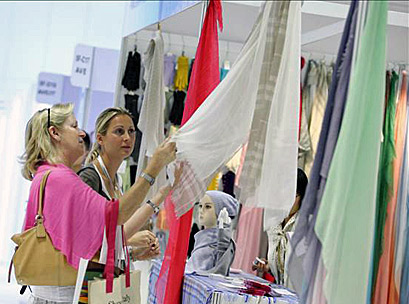Cashmere World has enjoyed a successful debut in Hong Kong, benefiting from the presence of international buying offices in the city and the synergy with the fair, Fashion Access.
Close to 2000 buyers from 50 countries viewed the fibres, yarns and finished cashmere products on offer.
Hong Kong registered the biggest number of visitors with 942, followed by mainland China with 500 and Japan with 114. The other countries/regions with the most buyers registered were Australia, India, Italy, South Korea, Taiwan, Russia and the US.
Seminars held during the fair “Peclers Paris’ FW13-14 Key Accessories Trends for Women/Men/Youth/Kids” and “Buying Accessories for the European Market” provided the latest trends for cashmere industry.
Besides, proving to be an important element of the fair was the conferences on “Solutions to Exporting Cashmere Products to Western Countries” and “Development & Trends in the Cashmere Trade”, offering different perspectives from different sectors of the cashmere industry.
Hao Xukuan, chairman of Viction Cashmere Group, took a supplier’s point of view, highlighting the position of China’s cashmere. Hao noted that China produces 200,000 tons of cashmere fibre a year, 70 per cent of which comes from Inner Mongolia.
However after the 2008 financial crisis, China was faced with a number of challenges: a strong currency, raw material price increases and rising labour and energy costs that chipped away at China’s cashmere advantage. The strict ecological production requirements of Western countries also created a barrier that kept many Chinese cashmere brands from entering the international market.
Hao believes that China must develop a good platform for its cashmere industry, developing it as a strong and reliable manufacturing base.
Another problem that China now faces is the lower sale price of cashmere which is killing the luxury image of cashmere and hence its profits. Hao believes that Chinese cashmere companies also must strive to develop a luxury brand image. Viction, for example, is now venturing into brand development with the end in view of marketing its own cashmere labels to domestic customers which he sees as a huge potentially profitable market.
The World Luxury Association (WLA) has forecast a sharp rise in the purchase of luxury goods until at least 2014/2015, with China leading the way. Already, Chinese purchases of luxury goods in France, Italy and the UK account for 48 per cent of all sales.
With China reducing its customs duties on imported luxury goods, starting October 2011, it is expected that luxury sales within China will increase considerably. Prestige cashmere labels from Italy and Scotland are already present in China but reduced import tariffs will make China even more attractive to international and Chinese brands.
Alessandra Cocchi, MD of EastMax Fashion, spoke from the perspective of a buyer. She has been watching the ongoing price war, with China buying up a quarter of greasy cashmere and creating a monopoly, she said.
Available quantities of greasy cashmere have been drastically reduced – China is down to 5000 – 6000 tons from 11,000 – 12,000 tons and Mongolia is now below 3000 tons down from 5000 – 6000 tons two to three years ago.
As an extension of the supply situation in China and Mongolia, China has been actively buying in Afghanistan and prices there have also surged up to Mongolian levels with most supplies depleted.
Cocchi is also concerned about the increasing number of cashmere goats, resulting in less grazing grassland per goat, therefore the fibre has become coarser. Breeding in quantity and not quality is not good for the future of cashmere industry, she warned.
Asian manufacturers have learned hard and fast about the cashmere business in the recent past, said Ronnie Lamb, an international cashmere consultant. Some of them are now ready to test their skills in the international market by launching their own brands.
“Brand is about reputation and branding is reputation building. Brand strategy and business strategy are related and works hand in hand. Good brands involve clarity, personality, reliability, trust, the promise of an experience, and the consistent delivery of that experience,” said Lamb.
Cashmere World is an integrated business platform for the international cashmere trade. Started in 2010, it has since become the annual meeting place for cashmere producers and buyers, a catalyst for innovations in cashmere production technology, and a venue for the promotion of cashmere materials.
GB






